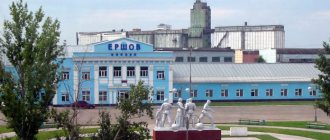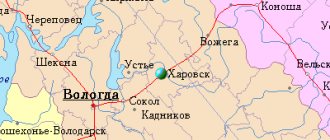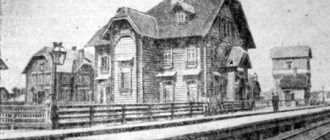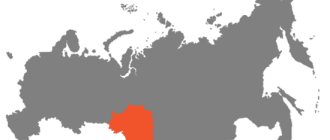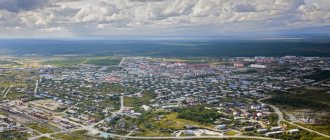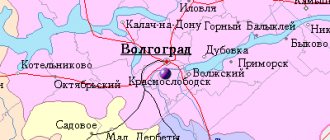| Flag of Bogotol (city) | Coat of arms of Bogotol (city) |
| A country | Russia |
| Subject of the federation | Krasnoyarsk region |
| Municipal district | Bogotolsky district |
| Telephone code | +7 39157 |
| Postcode | 662060 (Bogotol) 662061 (Bogotol 1) 662062 (Bogotol 2) 662063 (Bogotol 3) |
| Chapter | Artibyakin A. N. |
| Ethnobury | bogotolets, bogotolets, bogotolets |
| Coordinates | Coordinates: 56°12′00″ N. w. 89°31′00″ E. long / 56.2° north w. 89.516667° E. d. (G) (O) (I)56°12′00″ n. w. 89°31′00″ E. long / 56.2° north w. 89.516667° E. d. (G) (O) (I) |
| Vehicle code | 24, 84, 88, 124 |
| Center height | 290 m |
| Official site | https://bogotolcity.ru/ |
| Timezone | UTC+8 |
| City with | 1911 |
| Based | 1893 |
| Square | 60.91 km² |
| Population | ▼ 21,360 people (2010) |
| OKATO code | 04 406 |
Bogotol is a city (since 1911) in Russia, the administrative center of the Bogotolsky district of the Krasnoyarsk Territory, located on the Trans-Siberian Railway, 252 km west of Krasnoyarsk.
The head of the city is Andrey Nikolaevich Artibyakin (March 2008 - present).
Geography
Bogotol is located 6 km north of the Chulym River in the Achinsk forest-steppe on both sides of the railway.
The terrain of the city of Bogotol is characterized by slightly hilly forms, with a drop in relief observed to the north and southeast. A factor hindering the growth of the city is significant swampiness and occurrence of brown coal. The built-up part of the territory is 524 hectares.
Having a developed railway junction, the city of Bogotol is a city of regional subordination and the regional center of the district of the same name in the Krasnoyarsk Territory. The main external road connections of the city of Bogotol are carried out along the federal highway "Baikal" M53 and the regional highway "Bogotol-Tyukhtet".
Story
There are several versions of the origin of the city's name:
- hydronym from Ket Bogotul, where bogotu is the name of the Kets clan group, and ul is “river”,
- translation from the Turkic language - small (optionally, beautiful) valley.
Base
Founded in 1893 as a railway station with large railway workshops. In 1911, the village of Bogotol was transformed into a provincial town of the former Mariinsky district of the Tomsk province, and in 1925 it was included as a regional center in the Achinsky district.
Day of the city
City Day is celebrated on Railway Worker's Day. The city's first day was August 6, 1893. Now the city is 118 years old.
Symbolism
On July 3, 2008, by decision of the Bogotol City Council (No. 14-367), the flag and new coat of arms of the city were approved.
Cities
City of Bogotol
- a city in Russia, the administrative center of the Bogotolsky district of the Krasnoyarsk Territory, located on the Trans-Siberian Railway, 252 km west of Krasnoyarsk. The head of the city is Andrey Nikolaevich Artibyakin (March 2008 - present). In January 2010, a project to illuminate Sovetskaya Street with LED lights was launched. This is the first city where Russian-made LED lighting has been installed. On a 2 km long street, 46 LED lamps for outdoor lighting of the latest generation “Street-80”, produced by “Optogan”, were installed, which replaced the outdated traditional mercury arc lamps. Regional Energy Saving Company (subsidiary) acted as the general contractor for the project. Bogotol is located 6 km north of the Chulym River in the Achinsk forest-steppe on both sides of the railway. The terrain of the city of Bogotol is characterized by slightly hilly forms, with a drop in relief observed to the north and southeast. A factor hindering the growth of the city is significant swampiness and occurrence of brown coal. The built-up part of the territory is 524 hectares. Having a developed railway junction, the city of Bogotol is a city of regional subordination and the regional center of the district of the same name in the Krasnoyarsk Territory. The main external road connections of the city of Bogotol are carried out along the federal highway "Baikal" M53 and the regional highway "Bogotol-Tyukhtet". Currently, the city's population is 22 thousand people, 10.5 thousand of them are pensioners, 3 thousand of whom are disabled.
Education in the city of
Bogotol
The city has a number of secondary specialized, general education and preschool institutions. There are no institutions of higher professional education in the city, so future students go to other cities to enroll.
Economy of the city of
Bogotol
There is a car repair plant and a locomotive depot in the city. LLC “Plant of Metalwork Installation Tools”, formerly JSC “Bogotolsky Instrument”, is the largest tool enterprise in the industry. Bogotol, being the center of the grain-growing region, grows and processes agricultural products.
History of the city of
Bogotol
There are several versions of the origin of the name of the city: the hydronym from the Ket Bogotul, where Bogota is the name of the Kets clan group, and ul - “river”, translated from the Turkic language - small (or, alternatively, beautiful) valley. Founded in 1893 as a railway station with large railway workshops. In 1911, the village of Bogotol was transformed into a provincial town of the former Mariinsky district of the Tomsk province, and in 1925 it was included as a regional center in the Achinsky district. City Day is celebrated on Railway Worker's Day. The city's first day was August 6, 1893. Now the city is 118 years old.
| City coat of arms Bogotol— In a scarlet field at the green end, a rising silver unicorn with golden eyes, a horn and hooves, striking with its left front hoof the rim of a golden wheel placed below on the right. The coat of arms of the city of Bogotol, in accordance with the Methodological Recommendations for the development and use of official symbols of municipalities (Section 2, Chapter VIII, paragraphs 45-46), approved by the Heraldic Council under the President of the Russian Federation on June 28, 2006, can be reproduced with a status crown of the established pattern . Rationale for symbolism: The formation and development of Bogotol is largely connected with the Moscow-Siberian Highway, as well as with the Siberian Railway. Old Bogotol was a large village along the tract. The favorable location allowed the village to eventually become a significant trading center of the district, and during the construction of the railway in the 1890s, a railway station was formed in Bogotol. The modern city of Bogotol is one of the major railway junctions of the Krasnoyarsk Territory; numerous railway services are located here: a locomotive depot, a carriage depot, a track distance, a communication distance, a power supply section. Bogotol is a young, dynamically developing city (it acquired city status in 1911). The motto of the local residents was the phrase: “Bogotol residents believe in the future development of the city and Russia.” The figures of the coat of arms reflect the features of the city: - The unicorn is a historical symbol, used on the seal of the Krasnoyarsk prison in 1644, emphasizing the special role of Bogotol in the life of the Krasnoyarsk region. A unicorn resting on a wheel symbolizes the importance of the Bogotol transport hub for the economy of the entire region. — The unicorn is a traditional symbol of strength and invincibility, prosperity, prosperity, and life-giving energy. — The wheel is a symbol of forward movement, development, tirelessness; in the city’s coat of arms it also symbolizes a transport hub. Gold is a symbol of respect, intelligence, wealth, stability. Silver is a symbol of purity, perfection, peace and mutual understanding. Scarlet (red) color is a symbol of courage, strength, labor, beauty. Green color is a symbol of nature, health, vital growth; the city's coat of arms emphasizes the fertility of the Bogotol land. Author group: idea of the coat of arms: Konstantin Mochenov (Khimki), Oleg Milus (Moscow); artist and computer design: Oksana Fefelova (Balashikha), Galina Rusanova (Moscow); rationale for symbolism: Kirill Perekhodenko (Konakovo). Approved by the decision of the Bogotol City Council (#14-366) dated July 3, 2008. | City flag Bogotol— A rectangular red panel with a width to length ratio of 2:3, carrying a green stripe along the lower edge 2/9 of the width of the panel and reproducing the figures of the coat of arms: a unicorn and a wheel, made in white and yellow. Rationale for symbolism: The city’s flag is designed based on the coat of arms. The formation and development of Bogotol is largely connected with the Moscow-Siberian Highway, as well as with the Siberian Railway. Old Bogotol was a large village along the tract. The favorable location allowed the village to eventually become a significant trading center of the district, and during the construction of the railway in the 1890s, a railway station was formed in Bogotol. The modern city of Bogotol is one of the major railway junctions of the Krasnoyarsk Territory; numerous railway services are located here: a locomotive depot, a carriage depot, a track distance, a communication distance, a power supply section. Bogotol is a young, dynamically developing city (it acquired city status in 1911). The motto of the local residents was the phrase: “Bogotol residents believe in the future development of the city and Russia.” The figures of the flag reflect the features of the city: - The unicorn is a historical symbol, used on the seal of the Krasnoyarsk prison in 1644, emphasizing the special role of Bogotol in the life of the Krasnoyarsk region. The unicorn resting on a wheel symbolizes the importance of the Bogotol transport hub for the economy of the entire region. — The unicorn is a traditional symbol of strength and invincibility, prosperity, prosperity, and life-giving energy. — The wheel is a symbol of forward movement, development, tirelessness; in the city’s coat of arms it also symbolizes a transport hub. Yellow color (gold) is a symbol of respect, intelligence, wealth, stability. White color (silver) is a symbol of purity, perfection, peace and mutual understanding. Red color is a symbol of courage, strength, labor, beauty. Green color is a symbol of nature, health, vital growth; the city's coat of arms emphasizes the fertility of the Bogotol land. Author group: idea of the flag: Konstantin Mochenov (Khimki), Oleg Milus (Moscow); artist and computer design: Oksana Fefelova (Balashikha), Galina Rusanova (Moscow); rationale for symbolism: Kirill Perekhodenko (Konakovo). Approved by the decision of the Bogotol City Council (#14-367) dated July 3, 2008. |
Industry
Railway station "Bogotol"
- The city has a car repair plant and a locomotive depot.
- LLC “Plant of Metalwork Installation Tools”, formerly JSC “Bogotolsky Instrument”, is the largest tool enterprise in the industry.
- Bogotol, being the center of the grain-growing region, grows and processes agricultural products.
Demography
In the late 1760s - early 1770s, 6 parties of exiles were settled in winter quarters near the Kosulka River, the Black River, as well as at the Bogotolskaya and Achinskaya stations. In total, 459 people were accommodated at the Bogotolskaya station in the second half of the 18th century. In 1782, the village of Bogotol had 2,009 inhabitants and was a volost center.
| 1911 | 1917 | 1926 | 1939 | 1959 | 1963 | 1968 | 1975 | 1979 | 1992 | 1996 | 1998 | 2000 | 2002 | 2008 |
| 5.900 | 6.700 | 8.300 | 25.900 | 30.900 | 29.900 | 28.100 | 30.100 | 28.200 | 27.300 | 26.500 | 26.200 | 25.500 | 24.400 | 22.000 |
Currently, the city's population is 22 thousand people, 10.5 thousand of them are pensioners, 3 thousand of whom are disabled.
Links[edit]
Notes[edit]
- ^ abcdefg Law No. 10-4765
- ^ ab Encyclopedia of Russian Cities
. Moscow: Great Russian Encyclopedia. 2003. p. 50. ISBN 5-7107-7399-9. - ^ a b Federal State Statistics Service (2011). “All-Russian Population Census 2010. Volume 1" [All-Russian Population Census 2010, vol. 1]. All-Russian Population Census 2010 [All-Russian Population Census 2010]
. Federal State Statistics Service. - ^ abc Law No. 12-2510
- Law No. 13-2868
- "On the Calculation of Time". Official Internet portal of legal information
. June 3, 2011. Retrieved January 19, 2022. - Post office. Information and computing center of OASU RPO. ( Post office
).
Search for postal service objects ( postal Search for objects
) (in Russian) - ↑
Federal State Statistics Service of Russia (May 21, 2004).
“The population of Russia, the constituent entities of the Russian Federation as part of federal districts, urban settlements, settlements, settlements of 3 thousand or more people” [Population of Russia, its federal districts, federal districts, districts, urban settlements, rural settlements - administrative centers and rural settlements with a population of more than 3,000 people] (XLS). All-Russian Population Census 2002
. - “All-Union Population Census of 1989. The current population of union and autonomous republics, autonomous regions and districts, territories, negative phenomena, urban settlements and rural district centers” [All-Union Population Census of 1989: current population of union and autonomous republics, Autonomous regions and districts , territories, regions, districts, towns and villages performing the functions of district administrative centers. All-Union Population Census of 1989 [All-Union Population Census of 1989]
.
Institute of Demography of the National Research University: Higher School of Economics [Institute of Demography of the National Research University: Higher School of Economics]. 1989 - via Demoscope Weekly
.

